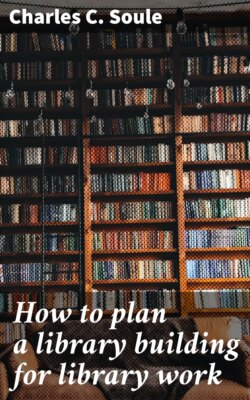Читать книгу How to plan a library building for library work - Charles C. Soule - Страница 28
На сайте Литреса книга снята с продажи.
Private and Club Libraries
ОглавлениеPrivate libraries, while a frequent problem for architects (in the United States there were over a hundred thousand in 1870, averaging 250 volumes to a library, according to the ninth census) have not much to interest librarians, who are seldom called in to run them. A private library is oftenest a more or less casual collection for the use of the owner and his family. Occasionally it expresses some special taste in reading or collecting. But whatever it includes, it is at the same time a store room and a reading room for a very few persons, as it was in old Roman times, so that it would be fitting for the architect to take the old Roman tone in its treatment, the tone of the Vatican library in miniature. Wall shelving, open or glassed cases, carvings, free decoration, busts above the bookcases, friezes, whatever he thinks appropriate and cozy, may be used in it.
Gladstone in his interesting article on “Books and the Housing of Them”[35] describes an arrangement for twenty thousand volumes (evidently his own library) “all visible, all within easy reach, in a room of quite ordinary size.” He sketches a floor plan of shallow piers or alcoves all around a room 20 × 40, with most of the centre left open for furniture. This plan is worth looking up by an architect charged with planning so large a private or club library.
A club library is only an extension of the private library idea, to be used by many men rather than by a few. Here the tone may be the same, varied perhaps by the first formal monastic features.
Here alcoves might well be used, with no rigid steel stacks, but handsome wooden shelving.
Just few enough men could find quiet seats, with books all around them, a cozy window seat with a leaded window to look out of, not too many other readers or busy attendants to disturb their quiet by hunting books on the neighboring shelves.
A private or club library is a good subject for an architect to exploit, taking beautifully bound books as the key to his ornamental treatment. Quiet, artistic lights are appropriate, rich old woods and decorative rugs; everything that is taboo in a public library. The keynotes should be rest, comfort, literary cosiness, private proprietorship; if anything more, refined hospitality to personal friends.
